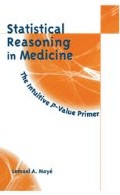Abstract
The previous chapter motivated complicated work. Because it has the advantage of fiscal efficiency and buttreses a causality argument, the clinical trial with multiple treatment arms and/or multiple endpoints is here to stay. It is the physician-scientist’s responsibility to incorporate these dual concerns of efficiency and epidemiology within the paradigm of significance testing. The investigator’s community protection responsibilities clearly require the unambiguous interpretation of type I errors in multiple endpoint clinical experiments. The p value is the probability that the therapy efficacy contained in the sample, through the play of chance, does not reflect the truth of no efficacy in the population. The occurrence of this (type I) error leads to the community of patients being exposed to a medication which is not effective but produces side effects. Thus, we may view a p value in therapy trials as the probability that a noxious or poison placebo is deemed (through the play of chance) to be effective. This noxious placebo may spread through the community as the false result is picked up and disseminated through the printed and, visual media, as well as through regulatory channel of the F. D. A. Thus, in a concordantly executed experiment, the smaller the p value, the smaller the probability that a noxious placebo will be deemed effective.
Access this chapter
Tax calculation will be finalised at checkout
Purchases are for personal use only
Preview
Unable to display preview. Download preview PDF.
References
Snedecor, G.W., and Cochran, W.G., (1980) Statistical Methods,7th Edition Iowa State University Press.
Moyé, L.A., (1998) “P value Interpretation and Alpha Allocation in Clinical Trials,” Annals of Epidemiology 8: 351–357.
Pfeffer, M.A., Braunwald, E., Moyé, L.A., Basta, L., Brown, E.J., Cuddy, T.E., Davis, B.R., Geltman, E.M., Goldman, S., Fiaker, G.C., Klein, M., Lamas, G.A., Packer, M., Rouleau, J., Rouleau, J.L., Rutherford, J., Wertheimer, J.H., and Hawkins, C.M. for the SAVE Investigators (1992) “Effect of Captopril on mortality and morbidity in patients with left ventricular dysfunction after myocardial infarction—results of the Survival and Ventricular Enlargement Trial,” New England Journal of Medicine 327: 669–677.
Sacks, F.M., Pfeffer, M.A., Moyé, L.A., Louleau, J.L., Rutherford, J.D., Cole, T.G., Brown, L., Warnica, J.W., Arnold, J.M.O., Wun, C.C., Davis, B.R., and Braunwald, E., (1996) for the Cholestrol and recurrent Events Trial Investigators. 1996. “The effect of pravastatin on coronary events after myocardial infarction in patients with average cholesterol levels,” New England Journal of Medicine 335: 1001–1009.
The Sytolic Hypertension in the Elderly Program (SHEP) Cooperative Research Group. (1991) “Prevention of Stroke by Anti-hypertensive Drug Therapy in Older Persons with Isolated Systolic Hypertension: Final Results of the Systolic Hypertension in the Elderly Program (SHEP),” Journal of the American Medical Association 265: 3255–3264.
Mahmarian, J.J., Moyé, L.A., Chinoy, D.A., Sequeira, R.F., Habib, G.B., Henry, W.J., Jain, A., Chaitman, B.R., Weng, C.S.W., MoralesBallejo, H., and Pratt, C.M., (1998) “Transdermal nitroglycerin patch therapy improves left ventricular function and prevents remodeling after acute myocardial infarction: results of a multicentre prospective randomized double-blind placebo controlled trial,” Circulation 97: 2017–2024.
The LRC Investigators. (1984) “The Lipid Research Clinics Coronary Primary Prevention trial results,” Journal of the American Medical Association 251: 351–374.
Cardiac Arrhythmia Suppression Trial (CAST) Investigators. “Preliminary report: effect of encainide and flecanide on mortality in a randomized trial of arrhythmia suppression after myocardial infarction,” New England Journal of Medicine 321: 227–233.
Linet, M.S., Hatch, E.E., Kleinerman, R.A., Robison, L.L., Kaune, W.T., Freidman, D.R., Severson, R.K., Haines, C.M., Hartsock, C.T., Niwa, S., Wacholder, S., and Tarone, R.E., (1997) “Residential Exposure to Magnetic Fields and acute lymphoblastic leukemia in children,” New England Journal of Medicine 337: 1–7.
Hayes, D.L., Wang, P.J., Reynolds, D.W., Estes, M., Griffith, J.L., Steffens, R.A., Carlo, G.L., Findlay, G.K., and Johnson, C.M., (1997) “Interference with cardiac pacemakers by cellular telephones,” New England Journal of Medicine 336: 1473–1479.
Westfall, P.H., and Young, S., “P value adjustments for multiple tests in multivariate binomial models,” Journal of the American Statistical Association 84: 780–786.
Lan, K.K.G., and Demets, D.L., (1983) “Discrete sequential boundaries for clinical trials,” Biometrika, 70: 659–663.
Lan, K.K.G., Simon, R., and Halperin, M. (1982) “Stochastically curtailed tests in long-term clinical trials,” Communications in Statistics C1: 207–209.
Davis, B.R., and Hardy, R.J., (1990) “Upper bounds for type I and type II error rates in conditional power calculations,” Communications in Statistics 19: 3571–3584.
Lan, K.K.G., and Wittes, J., (1988) “The b-value: a tool for monitoring data”. Biometrics, 44: 579–585.
Wesfall, P.H., Krishnen, A., and Young S., (1998) “Using prior information to allocate significance levels for multiple endpoints,” Statistics in Medicine 17: 2107–2119.
Author information
Authors and Affiliations
Rights and permissions
Copyright information
© 2000 Springer Science+Business Media New York
About this chapter
Cite this chapter
Moyé, L.A. (2000). P values and Multiple Endpoints II: Noxious Placebos in the Population. In: Statistical Reasoning in Medicine. Springer, New York, NY. https://doi.org/10.1007/978-1-4757-3292-4_9
Download citation
DOI: https://doi.org/10.1007/978-1-4757-3292-4_9
Publisher Name: Springer, New York, NY
Print ISBN: 978-0-387-98933-4
Online ISBN: 978-1-4757-3292-4
eBook Packages: Springer Book Archive

